Legislative Update
Senate Leaders to Start Over on No Child Left Behind
By Jodi Peterson
Posted on 2015-02-08
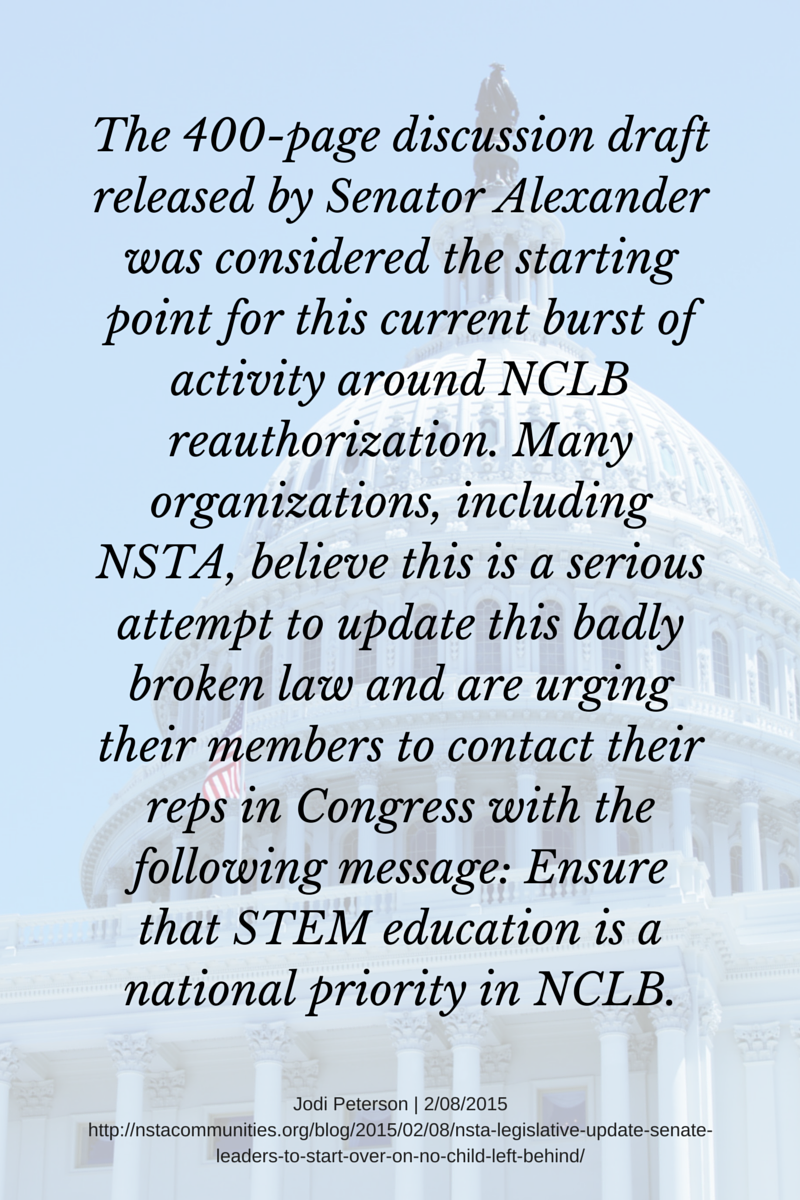 Last week the Washington Post reported that Senator Lamar Alexander (R-TN) and Senator Patty Murray (D-WA), chair and ranking member of the Senate Health, Education, Labor & Pensions (HELP) Committee respectively, will work together to draft a bipartisan bill to reauthorize No Child Left Behind (NCLB), instead of working from a discussion draft bill introduced by Committee Chairman Lamar Alexander a few weeks ago and “they are determined to find common ground and draft a new law that will get bipartisan support.”
Last week the Washington Post reported that Senator Lamar Alexander (R-TN) and Senator Patty Murray (D-WA), chair and ranking member of the Senate Health, Education, Labor & Pensions (HELP) Committee respectively, will work together to draft a bipartisan bill to reauthorize No Child Left Behind (NCLB), instead of working from a discussion draft bill introduced by Committee Chairman Lamar Alexander a few weeks ago and “they are determined to find common ground and draft a new law that will get bipartisan support.”
As noted in a Jan. 19 blog post, the 400-page discussion draft released by Senator Alexander was considered the starting point for this current burst of activity around NCLB reauthorization. Many organizations, including NSTA, believe this is a serious attempt to update this badly broken law and are urging their members to contact their reps in Congress with the following message: Ensure that STEM education is a national priority in NCLB. Please use the STEM Education Coalition website and contact your members of Congress with this message.
With these new developments, it is highly unlikely that the Senate HELP committee will push out any NCLB legislation by the end of February.
Also last week, Republican education leaders in the House introduced their bill to replace No Child Left Behind. The Student Success Act (H.R. 5) will reduce the federal footprint and restore local control, while empowering parents and education leaders to hold schools accountable for effectively teaching students.
In other legislative news, the President’s budget released last week had some good news for science and STEM education:
- $3 billion for STEM education programs in total across 13 federal agencies, an increase of 3.6 percent over the 2015 enacted level
- $202.7 million for the existing Math and Science Partnership program, a $50 million increase over FY15. The budget also proposes reserving $25 million of this funding for competitive grants to support state and regional STEM networks and a reservation of 5% for “national” activities
- $125 million for a new program called Next Generation High Schools, which would promote the whole school transformation of high school education. The Department would place a strong focus on projects designed to improve readiness for college and careers in STEM fields, particularly for student groups historically underrepresented in those fields.
At the National Science Foundation,funding for the NSF’s Education and Human Resources Directorate is proposed at $962.57 million, an increase of $96 million of 11.2% over FY 2015. Funding for the STEM+Computer Science Partnerships Program is proposed for $64 million, an increase of $7 million. [This includes $52 million from EHR and $12.5 million from the Computing Research Directorate (CISE).]
Stay tuned and look for upcoming issues of NSTA Express for the latest information on developments in Washington, DC.
Jodi Peterson is Assistant Executive Director of Legislative Affairs for the National Science Teachers Association (NSTA) and Chair of the STEM Education Coalition. e-mail Jodi at jpeterson@nsta.org; follower her on Twitter at @stemedadvocate.
The mission of NSTA is to promote excellence and innovation in science teaching and learning for all.
Follow NSTA
 Last week the Washington Pos
Last week the Washington Pos
Using Physical Science Gadgets and Gizmos in Elementary Grades
By Carole Hayward
Posted on 2015-02-08
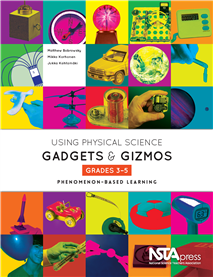 The authors of the popular Phenomenon-Based Learning series have released a new book geared toward elementary-age students. Using Physical Science Gadgets & Gizmos, Grades 3-5: Phenomenon-Based Learning is the latest book by Matthew Bobrowsky, Mikko Korhonen, and Jukka Kohtamäki. The activities they include are designed to building learning on observations of real-world phenomena—in this case of some fun toys or gadgets.
The authors of the popular Phenomenon-Based Learning series have released a new book geared toward elementary-age students. Using Physical Science Gadgets & Gizmos, Grades 3-5: Phenomenon-Based Learning is the latest book by Matthew Bobrowsky, Mikko Korhonen, and Jukka Kohtamäki. The activities they include are designed to building learning on observations of real-world phenomena—in this case of some fun toys or gadgets.
In the phenomenon-based learning (PBL) approach, students work and explore collaboratively: Exercises are done in groups, and students’ conclusions are also drawn in groups. “With the PBL strategy, the concepts and the phenomena are approached from different angles, each adding a piece to the puzzle with the goal of developing a picture correctly portraying the real situation.” In other words, it’s not so much a teaching method as it is a route to grasping the big picture.
The 30 PBL activities included in the book are divided into 8 main categories. Here are some examples of the fun you and your students can have while teaching and learning important science concepts:
- Speed: Using a Constant-Velocity Car, learn about constant speed, and measure some speeds with simple tools.
- Friction and Air Resistance: With an Air Puck, study how objects act if there is very little friction.
- Gravity: Using an IR-Controlled UFO Flyer, explore how gravitation tries to pull things toward the ground.
- Air Pressure: Using an Air-Powered Projectile, see the effect of gravitation and excess pressure.
- Electricity: With a Plasma Globe, explore electric charges and the phenomenon they cause called static electricity.
- Electric Circuits: Using a Hand Crank from a Snaptricity (a box of electric components that snap together for easy use), create a voltage just like a battery and light up a lamp.
- Magnetism: From the same Snaptricity box, take the compass and find out what it does when a bar magnet is brought close to it.
- Energy: Using a music box, explore moving energy with sound to learn what makes hearing possible.
The authors emphasize three reasons to buy this book:
- To improve your students’ thinking skills and problem-solving abilities.
- To get easy-to-perform experiments that engage students in the topic.
- To make your physics lessons waaaaay more cool.
Ordering information for all of the gadgets and gizmos used in the book is included. This book is also available as an e-book. Learn more about the other books in this series.
Changing careers
By Mary Bigelow
Posted on 2015-02-06
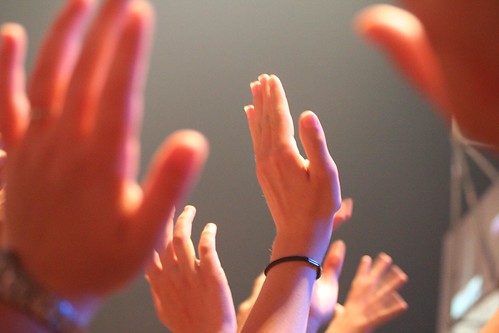 I am thinking of switching careers to become a secondary science teacher (I currently work for an environmental agency). Before I decide, what should I consider? —S., Connecticut
I am thinking of switching careers to become a secondary science teacher (I currently work for an environmental agency). Before I decide, what should I consider? —S., Connecticut
Being a science teacher is a rewarding and challenging experience, helping students develop and pursue their own interests in a subject you are passionate about. Many of our students have never met a scientist in person, and with your background, you can show students how science connects with the “real” world. You can also share the variety of work that scientists do beyond the lab—reports, letters, presentations, and other communications. Some schools may prefer “nontraditional” beginning teachers such as you, who bring life experiences and in-depth content background to the classroom.
You may want to see if a nearby middle or high school will let you “shadow” a science teacher for a day to see for yourself the challenges of working with 25 teenagers in a classroom. Secondary teachers usually have 4-6 sections, interacting with 100-150 students each day, including students with special needs or students learning the English language. Teachers may be assigned to teach more than one subject, depending on their certification. Note the types of technology that teachers use and how they manage their labs (most often without an assistant). You’ll also see other parts of a teacher’s day, including supervision duties in the halls and lunchroom, extracurricular activities, and tutoring.
But a teacher’s day does not end at 3:00, as I assume you realize. Staff meetings, professional development sessions, and managing a laboratory all require time beyond the school day. And teachers have their own “homework”—grading lab reports and tests, planning and revising lessons, preparing and organizing other learning materials, and keeping current on content and pedagogy through courses, workshop, and on-line studies. Much of this homework continues over holiday and summer breaks.
The state’s education department website should have a section on the science standards by grade level or subject and information on any standardized assessments that are administered at the secondary level, including end-of-course exams, for which you would be responsible. (If your state has adopted the Next Generation Science Standards, NSTA has a wealth of resources to help you become familiar with them. See NGSS@NSTA)
Check out the job situation at the schools in the area(s) in which you would like to work. Are they hiring new teachers? Are the schools downsizing or eliminating positions? Keep in mind you’ll probably start at a low level of the pay scale.
In places where there is a surplus of teachers, many start out doing substitute work (per diem pay and no benefits), which is a good way to share your availability and showcase your talents. In addition to schools, other types of institutions often hire informal educators, curators, or naturalists: museums, nature centers, zoos, and state or national parks. These positions may be part-time and depend on the funding levels of the institutions.
While you’re on the state department of education site, check out the certification requirements for teaching K-12 science. The state may credential science teachers by discipline (e.g., chemistry, biology, physics, earth and space, environmental, or general science) or by age level (primary, elementary, secondary, middle, or high). You could investigate multiple certifications, including special education.
Depending on the certification(s) in which you’re interested, you may need additional content coursework, and you’ll definitely need background in pedagogy, assessment, educational technology, and classroom lab safety. Before enrolling in any higher-education institution’s teacher program, ask a lot of questions. Does your state accept the coursework and degree from the institution for a teaching certification? What accreditation does it have? What percent of the graduates find teaching positions? What experience and background do the education professors and the science professors have, especially with the science standards? What kind of practicum or internship is offered?
Good luck with your fact-finding and decision-making!
 I am thinking of switching careers to become a secondary science teacher (I currently work for an environmental agency). Before I decide, what should I consider? —S., Connecticut
I am thinking of switching careers to become a secondary science teacher (I currently work for an environmental agency). Before I decide, what should I consider? —S., Connecticut
NSTA’s K–12 Science Education Journals: February 2015 Issues Online
By Lauren Jonas, NSTA Assistant Executive Director
Posted on 2015-02-04
Energy and Matter; Science and Language Arts; and Obtaining, Evaluating, and Communicating Information—these are the themes of the February 2015 journal articles from the National Science Teachers Association (NSTA). Browse through the thought-provoking selections below and learn more about how your brain pays attention, the synergy between physical education and physical science, reading and writing alignment across content areas, teaching graph literacy, confronting ambiguity in science, modeling molecular machinery, the Next Generation Science Standards (NGSS), and other important topics in K–12 science education.
Science and Children
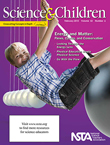 Energy and Matter is one of the most difficult of the crosscutting concepts in the Next Generation Science Standards for elementary teachers to develop. The ideas, tips and strategies in this issue of S&C will help equip you to introduce this crosscutting concept to your students
Energy and Matter is one of the most difficult of the crosscutting concepts in the Next Generation Science Standards for elementary teachers to develop. The ideas, tips and strategies in this issue of S&C will help equip you to introduce this crosscutting concept to your students
Featured articles (please note, only those marked “free” are available to nonmembers without a fee):
- Free – Editor’s Note: Energy and Matter
- Go With the Flow
- How Does My Brain Pay Attention?
- Inquiry-Based Science and the Next Generation Science Standards: A Magnetic Attraction
- Free – Looking Through the Energy Lens
- Physical Education Meets Physical Science
- Full Table of Contents
Science Scope
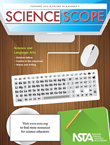 The Common Core State Standards for English language arts (CCSS ELA) and the Next Generation Science Standards (NGSS) share common goals for student literacy. This issue explores strategies for achieving literacy in science and technical subjects for students in grades 6–8.
The Common Core State Standards for English language arts (CCSS ELA) and the Next Generation Science Standards (NGSS) share common goals for student literacy. This issue explores strategies for achieving literacy in science and technical subjects for students in grades 6–8.
Featured articles (please note, only those marked “free” are available to nonmembers without a fee):
- Comic Relief: Using Comics and Illustrated Trade Books to Support Science Learning in First-Year English Language Learners
- Free – Editor’s Roundtable: Literacy Provides Common Ground for standards
- Free – Reading and Writing Alignment Across Content Areas
- Science Haiku Art
- Teaching Graph Literacy Across the Curriculum
- The Who, What, When, Where, and How of Waves
- Using Disciplinary Literacy Strategies to Enhance Student Learning
- Full Table of Contents
The Science Teacher
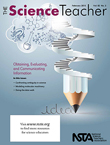 It’s arguable that all science learning begins and ends with obtaining, evaluating, and communicating information. We think of scientists and engineers working in the laboratory or outside during field research, but it turns out that reading and writing comprise over half the work of practicing scientists and engineers. Communicating science and engineering understanding is challenging, but the rewards are great, giving students a unique opportunity to synthesize ideas and solidify understanding. You can start by having students keep a science notebook or journal—including drawings, numbers, and words. We hope this issue inspires you to reinforce this important practice in the classroom. YouTube fans, watch high school science teacher and TST Field Editor, Steve Metz, introduce this month’s issue. Metz explains why this month’s topic so important. For starters, did you know that reading and writing comprise over half the work of practicing scientists and engineers?
It’s arguable that all science learning begins and ends with obtaining, evaluating, and communicating information. We think of scientists and engineers working in the laboratory or outside during field research, but it turns out that reading and writing comprise over half the work of practicing scientists and engineers. Communicating science and engineering understanding is challenging, but the rewards are great, giving students a unique opportunity to synthesize ideas and solidify understanding. You can start by having students keep a science notebook or journal—including drawings, numbers, and words. We hope this issue inspires you to reinforce this important practice in the classroom. YouTube fans, watch high school science teacher and TST Field Editor, Steve Metz, introduce this month’s issue. Metz explains why this month’s topic so important. For starters, did you know that reading and writing comprise over half the work of practicing scientists and engineers?
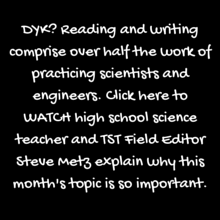 Featured articles (please note, only those marked “free” are available to nonmembers without a fee):
Featured articles (please note, only those marked “free” are available to nonmembers without a fee):
- Beyond an Equation
- Confronting Ambiguity in Science
- Doing the Data Walk
- Free – Editor’s Corner: Obtain, Evaluate, Communicate!
- Modeling Molecular Machinery
- Sinking In
- Full Table of Contents
Get these journals in your mailbox as well as your inbox—become an NSTA member!
Follow NSTA
Energy and Matter; Science and Language Arts; and Obtaining, Evaluating, and Communicating Information—these are the themes of the February 2015 journal articles from the National Science Teachers Association (NSTA).
It’s a Great Time for the Latest Next Time You See Books
By Carole Hayward
Posted on 2015-02-03
Emily Morgan, popular NSTA Press co-author of the Picture-Perfect Science Lessons series, has recently added three new books to the Next Time You See series: Next Time You See a Maple Seed, Next Time You See the Moon, and Next Time You See a Pill Bug.
In a note to parents and teachers, Morgan explains that “the books in this series are intended to be read with a child after he or she has had some experience with the featured objects or phenomena….The Next Time You See books are not meant to present facts to be memorized. They were written to inspire a sense of wonder about ordinary objects or phenomena and foster a desire to learn more about the natural world.”
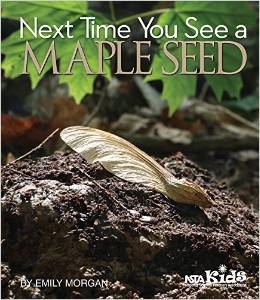 What we often call maple seeds are really the fruit produced by a maple tree. These winged fruits are known as samaras. They are also a source of delight for children as they watch them spin through the air like tiny helicopters. Have you and your students ever wondered why they do that? Learn about maple seeds and what it takes for one to actually grow into a maple tree.
What we often call maple seeds are really the fruit produced by a maple tree. These winged fruits are known as samaras. They are also a source of delight for children as they watch them spin through the air like tiny helicopters. Have you and your students ever wondered why they do that? Learn about maple seeds and what it takes for one to actually grow into a maple tree.
 The Moon has fascinated mankind through the ages. Its beauty and changing shape have inspired art, music, poetry, and storytelling throughout history. Have you and your students ever discussed why the Moon appears to have different shapes at different times of the month? The explanations and stunning photography in this book can help your students understand more about the Moon’s orbit and its different phases.
The Moon has fascinated mankind through the ages. Its beauty and changing shape have inspired art, music, poetry, and storytelling throughout history. Have you and your students ever discussed why the Moon appears to have different shapes at different times of the month? The explanations and stunning photography in this book can help your students understand more about the Moon’s orbit and its different phases.
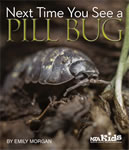 The pill bug is a tiny roly-poly creature often found under rocks. Studying these members of the crustacean family, you and your students will learn that pill bugs are actually isopods, which means that all 14 of their feet are the same. This makes them different from their cousins, the crab and the lobster.
The pill bug is a tiny roly-poly creature often found under rocks. Studying these members of the crustacean family, you and your students will learn that pill bugs are actually isopods, which means that all 14 of their feet are the same. This makes them different from their cousins, the crab and the lobster.
These books also have downloadable companion classroom activities: Next Time You See a Maple Seed, Next Time You See the Moon, and Next Time You See a Pill Bug. These activities are designed to be done before and after reading the books. Feel free to pick and choose from the list based on the age of the children and your purpose for reading.
These books are also available as e-books: Next Time You See a Maple Seed, Next Time you See the Moon, and Next Time You See a Pill Bug
NSTA Kids book are trade books dedicated to nurturing the wonder and curiosity inherent in young minds. Learn more about these books geared toward elementary-age students (grades K–6).
Emily Morgan, popular NSTA Press co-author of the Picture-Perfect Science Lessons series, has recently added three new books to the Next Time You See series: Next Time You See a Maple Seed, Next Time You See the Moon, and Next Time You See
The Science of Design: Structure and Function: Featured Strand at NSTA’s 2015 National Conference on Science Education in Chicago, IL, March 12-15
By Lauren Jonas, NSTA Assistant Executive Director
Posted on 2015-01-31
 If you’ve been to Chicago, you know it’s an ideal place to focus on design and architecture. So this March, the National Science Teachers Association (NSTA) will feature a special strand “The Science of Design: Structure and Function” at our 2015 National Conference on Science Education, in Chicago, March 12–15. Our conference organizers recognize that architecture and engineering provide the infrastructure for human-made systems, that designing for the future requires imagination and a commitment to sustainability, and that teaching about this involves the crosscutting concepts of structure and function and the practices of science and engineering. Communities like Chicago provide examples of great design and great science.
If you’ve been to Chicago, you know it’s an ideal place to focus on design and architecture. So this March, the National Science Teachers Association (NSTA) will feature a special strand “The Science of Design: Structure and Function” at our 2015 National Conference on Science Education, in Chicago, March 12–15. Our conference organizers recognize that architecture and engineering provide the infrastructure for human-made systems, that designing for the future requires imagination and a commitment to sustainability, and that teaching about this involves the crosscutting concepts of structure and function and the practices of science and engineering. Communities like Chicago provide examples of great design and great science.
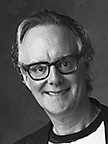 Sessions organized around this strand include a featured presentation on Friday, March 13, 9:30 AM – 10:30 AM (“The Power of Play”) by Peter Exley (Architecture is Fun, Inc.: Chicago, IL). Not familiar with Exley? Check out this profile on him in Chicago Artists Month. And there will be hundreds more sessions in Chicago that highlight great design and great science; below is a small sampling so you see what’s in store:
Sessions organized around this strand include a featured presentation on Friday, March 13, 9:30 AM – 10:30 AM (“The Power of Play”) by Peter Exley (Architecture is Fun, Inc.: Chicago, IL). Not familiar with Exley? Check out this profile on him in Chicago Artists Month. And there will be hundreds more sessions in Chicago that highlight great design and great science; below is a small sampling so you see what’s in store:
- The Maker Movement
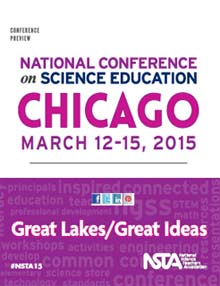
- From the Love Canal to Phytoremediation: What’s New in Environmental Engineering?
- Engaging Girls in Engineering Through Community Service
- McREL Pathway Session: Green STEM in Elementary Classrooms
- Understanding Car Crashes: Engineering Truly Impactful STEM Lessons
- Helping Middle School Students “Discover Engineering”
- Eco-Structure and Function: Analyzing River Health with Engineering Practices in Problem-based Situations
- Engineering Design Inspired by Nature
Want more? Check out more sessions and other events with the Chicago Session Browser/Personal Scheduler, or take a peek at the online conference preview (pdf). Follow all our conference tweets using #NSTA15, and if you tweet, please feel free to tag us @NSTA so we see it!
The mission of NSTA is to promote excellence and innovation in science teaching and learning for all.
Follow NSTA
| |
|
|
|
Teaching Every Child by Embracing Diversity: Featured Strand at NSTA’s 2015 National Conference on Science Education in Chicago, IL, March 12-15
By Lauren Jonas, NSTA Assistant Executive Director
Posted on 2015-01-31
 This March, the National Science Teachers Association (NSTA) will feature a special strand “Teaching Every Child by Embracing Diversity” at our 2015 National Conference on Science Education, in Chicago, March 12–15. We’re starting with the knowledge that all classrooms are diverse; learners bring a variety of cultures, backgrounds, and experiences to the study of science. So we want to help educators find new ideas and resources for meeting the needs of all students, including English language learners, students with special needs, and those with diverse learning styles and abilities. Successful instructional approaches must address methods, materials, facilities, and partnerships. These sessions will confirm the belief that every student can excel in science.
This March, the National Science Teachers Association (NSTA) will feature a special strand “Teaching Every Child by Embracing Diversity” at our 2015 National Conference on Science Education, in Chicago, March 12–15. We’re starting with the knowledge that all classrooms are diverse; learners bring a variety of cultures, backgrounds, and experiences to the study of science. So we want to help educators find new ideas and resources for meeting the needs of all students, including English language learners, students with special needs, and those with diverse learning styles and abilities. Successful instructional approaches must address methods, materials, facilities, and partnerships. These sessions will confirm the belief that every student can excel in science.
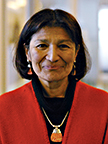 Sessions organized around this strand include a featured presentation on Thursday, March 12 3:30 PM – 4:30 PM (“Next Generation Science Standards and English Language Learners: The Development of Deep and Generative Practices”) by Aída Walqui (WestEd: San Francisco, CA). Not familiar with Walqui? Check out this interview in Language Magazine, where she discusses Five Principles for Succeeding with Adolescent English Learners. And there will be hundreds more sessions in Chicago to inspire teachers who want every student to have the chance to succeed in science; below is a small sampling so you see what’s in store:
Sessions organized around this strand include a featured presentation on Thursday, March 12 3:30 PM – 4:30 PM (“Next Generation Science Standards and English Language Learners: The Development of Deep and Generative Practices”) by Aída Walqui (WestEd: San Francisco, CA). Not familiar with Walqui? Check out this interview in Language Magazine, where she discusses Five Principles for Succeeding with Adolescent English Learners. And there will be hundreds more sessions in Chicago to inspire teachers who want every student to have the chance to succeed in science; below is a small sampling so you see what’s in store:
 Aprendamos Juntos! (Let’s Learn Together): Embracing Native Languages in Non-bilingual Classrooms to Build Intermediate Science Literacy in English
Aprendamos Juntos! (Let’s Learn Together): Embracing Native Languages in Non-bilingual Classrooms to Build Intermediate Science Literacy in English- Mixed Media Journaling in the Diverse Science Classroom
- SC-10: STEM for ALL: Practices and Methods that Promote Equal Access to STEM
- A New Movement: Thinking on Your Feet
- Science for Bl(all)ck Children: Making Meaning Through Language and Culture
- Implementing the 3-E Instructional Model to Enhance Science Learning Experiences for Students with Special Needs
- Your Kids Can, Too! Scientific Argumentation for All Students
- Any Time, Any Place, Any Pace Lab Science
- El Club de Padres: Maximize Science Learning for Your Bilingual Students by Promoting a Learning Partnership with Their Parents
Want more? Check out more sessions and other events with the Chicago Session Browser/Personal Scheduler, or take a peek at the online conference preview (pdf). Follow all our conference tweets using #NSTA15, and if you tweet, please feel free to tag us @NSTA so we see it!
The mission of NSTA is to promote excellence and innovation in science teaching and learning for all.
Follow NSTA
| |
|
|
|
 This March, the National Science Teachers Association (NSTA) will feature a special strand “Teaching Every Child by Embracing Diversity” at our
This March, the National Science Teachers Association (NSTA) will feature a special strand “Teaching Every Child by Embracing Diversity” at our
Finding books about systems in cold weather
By Peggy Ashbrook
Posted on 2015-01-31
 In cold weather children’s systems of clothing for comfort may become more complicated with added parts of boots, leg warmers, mittens, scarves, hats and coats with multiple fastenings. Reading a book aloud during the time it takes children to get dressed to go outside can help those who are fastest be patient while waiting for others to finish.
In cold weather children’s systems of clothing for comfort may become more complicated with added parts of boots, leg warmers, mittens, scarves, hats and coats with multiple fastenings. Reading a book aloud during the time it takes children to get dressed to go outside can help those who are fastest be patient while waiting for others to finish.
 Sneezy the Snowman by Maureen Wright is recommended by Kathy’s Book Corner at ScienceStart! for introducing the topic of freezing and melting (changing the state of matter from a solid to a liquid.) Kathy Conezio suggests activities to do at home or school related to the theme of the books she reviews. You can also find videos of books being read aloud by Jessica Bruederle and other readers, but nothing beats sitting on a lap or gathering by a knee to listen to a story being read from an actual book. The reader can pause to ask children what they think might happen next or to describe a time they had a similar experience.
Sneezy the Snowman by Maureen Wright is recommended by Kathy’s Book Corner at ScienceStart! for introducing the topic of freezing and melting (changing the state of matter from a solid to a liquid.) Kathy Conezio suggests activities to do at home or school related to the theme of the books she reviews. You can also find videos of books being read aloud by Jessica Bruederle and other readers, but nothing beats sitting on a lap or gathering by a knee to listen to a story being read from an actual book. The reader can pause to ask children what they think might happen next or to describe a time they had a similar experience.
Do you use videos for story time or for children to revisit favorite books? What technology system works best in your home or program?
![]() NSTA Recommends is another wonderful resource for finding books that are scientifically accurate and useful for learning about science concepts in early childhood. Build It! Structures, Systems and You by Adrianne Mason describes many systems and their parts. While the text level of Snow and People by Nikki Bundy is recommended for grades 2 and above, the photographs and labeled illustrations will engage preschoolers in talking about their clothing system for keeping warm.
NSTA Recommends is another wonderful resource for finding books that are scientifically accurate and useful for learning about science concepts in early childhood. Build It! Structures, Systems and You by Adrianne Mason describes many systems and their parts. While the text level of Snow and People by Nikki Bundy is recommended for grades 2 and above, the photographs and labeled illustrations will engage preschoolers in talking about their clothing system for keeping warm.
I asked my local librarian for books about light and shadow and she found many non-fiction books that address science concepts such as, “How is a shadow formed?” Local libraries—another example of a system!
ESEA is Moving —Call your Representatives, Let your Voice Be Heard
By Jodi Peterson
Posted on 2015-01-30
 Work to reauthorize the Elementary and Secondary Education Act, otherwise known as No Child Left Behind, is moving quickly in both the Senate and the House. A Senate draft discussion is being circulated and a bill is expected to be introduced shortly. In the U. S. House of Representatives, we anticipate introduction of a Republican bill (version passed by House in 2013) soon, with markup to follow.
Work to reauthorize the Elementary and Secondary Education Act, otherwise known as No Child Left Behind, is moving quickly in both the Senate and the House. A Senate draft discussion is being circulated and a bill is expected to be introduced shortly. In the U. S. House of Representatives, we anticipate introduction of a Republican bill (version passed by House in 2013) soon, with markup to follow.
It has taken many years for Congress to reauthorize this law, and the efforts in the Senate seem promising. But instead of being a priority in federal education policy, STEM is becoming lost.
Educators are urged to contact their members of Congress immediately, and ask them to make STEM education a national priority. At the Legislative Action Center of the STEM Education Coalition website, you can send a letter to your elected representatives, which asks them to
- Maintain a strong focus on science, technology, engineering, and math (STEM) education.
- Continue the focus on math and science as required elements of any state’s accountability system.
- Provide states with dedicated funding to support STEM-related activities and teacher training.
We need your help getting this message heard and to get as much support as possible for science and STEM education. Please take a moment to write to your elected officials, and send this message to your networks.
Read background on this, find out what happened at the Senate hearing last week on teaching and learning, and get insight from Senator Alexander on No Child Left Behind.
Questions? e-mail me at jpeterson@nsta.org.
Jodi Peterson is Assistant Executive Director of Legislative Affairs for the National Science Teachers Association (NSTA) and Chair of the STEM Education Coalition. e-mail Jodi at jpeterson@nsta.org; follower her on Twitter at @stemedadvocate.
The mission of NSTA is to promote excellence and innovation in science teaching and learning for all.
Follow NSTA
| |
|
|
|
Help Your Students Become Proficient in Science Through Argument-Driven Inquiry
By Carole Hayward
Posted on 2015-01-29
“The new aim of science education in the United States is for all students to become proficient in science by the time they finish high school. The argument-driven inquiry (ADI) instruction model was designed as a way to make lab activities more authentic and educative for students and thus help teachers promote and support the development of science proficiency.”
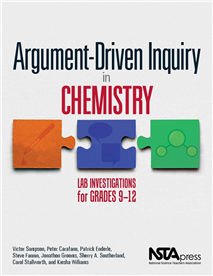 The 30 lab investigations in the new NSTA Press book Argument-Driven Inquiry in Chemistry, Lab Investigations for Grades 9-12 follow the ADI instruction model. Authors Victor Sampson, Patrick Enderle, Leeanne Gleim, Jonathon Grooms, Melanie Hester, Sherry Southerland, and Kristin Wilson organize the book into two parts. Part I describes the 8 stages of the ADI instructional model and the development and components of the ADI lab investigations. Part II contains the lab investigations, including notes for the teacher, student handouts, and checkout questions.
The 30 lab investigations in the new NSTA Press book Argument-Driven Inquiry in Chemistry, Lab Investigations for Grades 9-12 follow the ADI instruction model. Authors Victor Sampson, Patrick Enderle, Leeanne Gleim, Jonathon Grooms, Melanie Hester, Sherry Southerland, and Kristin Wilson organize the book into two parts. Part I describes the 8 stages of the ADI instructional model and the development and components of the ADI lab investigations. Part II contains the lab investigations, including notes for the teacher, student handouts, and checkout questions.
The investigations included in the book are not meant to replace an existing curriculum but rather to transform the laboratory component of a chemistry course. A teacher can use these investigations as a way to introduce students to new content or as a way to give students an opportunity to apply a theory, law, or unifying concept introduced in class in a novel situation.
Here are a few examples of the lab investigations:
Structure and Properties of Matter
Introduction Lab
- Molecular Shapes: How Does the Number of Substituents Around a Central Atom Affect the Shape of a Molecule?
- Temperature Changes Due to Evaporation: Which of the Available Substances Has the Strongest Intermolecular Forces?
Application Lab
- Melting and Freezing Points: Why Do Substances Have Specific Melting and Freezing Points?
- Density and the Periodic Table: What Are the Densities of Germanium and Flerovium?
Chemical Reactions
Introduction Lab
- Characteristics of Acids and Bases: How Can the Chemical Properties of an Aqueous Solution Be Used to Identify It as an Acid or a Base? (Free lab)
- Reaction Rates: Why Do Changes in Temperature and Reactant Concentration Affect the Role of a Reaction?
Application Lab
- Composition of Chemical Compounds: What Is the Empirical Formula of Magnesium Oxide?
- Designing a Cold Pack: Which Salt Should Be Used to Make an Effective but Economical Cold Pack?
The book also includes Standards alignment matrixes, options for implementing ADI lab investigations, investigation proposal options, a peer-review guide, and an instructor-scoring rubric.
This book is also available as an e-book.
“The new aim of science education in the United States is for all students to become proficient in science by the time they finish high school. The argument-driven inquiry (ADI) instruction model was designed as a way to make lab activities more authentic and educative for students and thus help teachers promote and support the development of science proficiency.”


